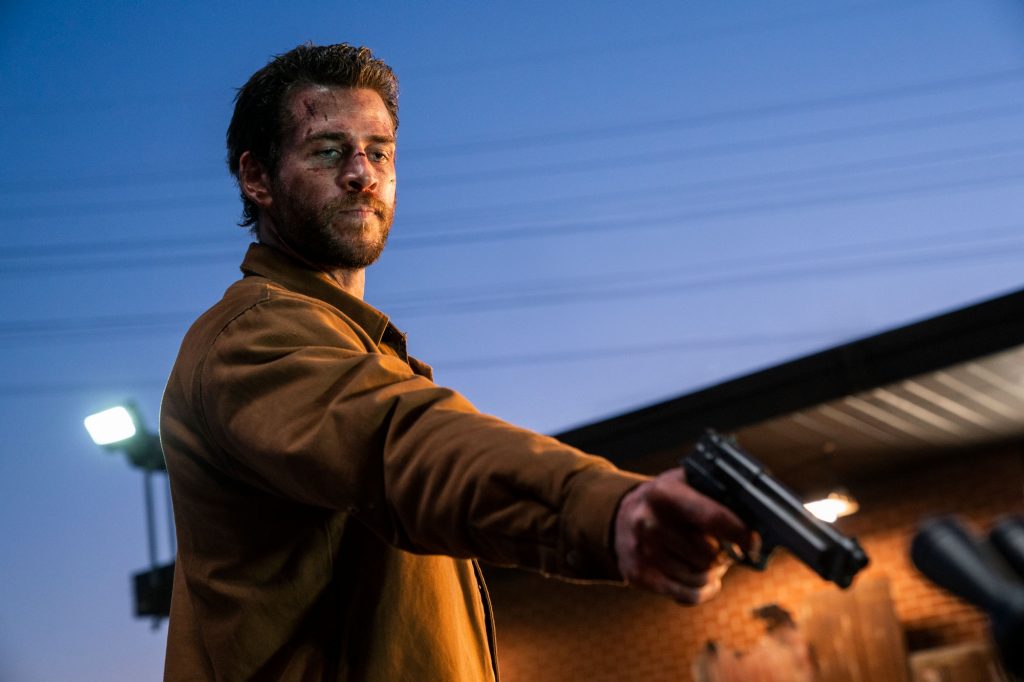Aaron Poole, action, Christoph Waltz, drama, Liam Hemsworth, Most Dangerous Game, movies, Phil Abraham, Quibi, Sarah Gadon, TV, Zach Cherry
April 22, 2020
by Carla Hay

Directed by Phil Abraham
Culture Representation: Taking place in Detroit, the action drama “Most Dangerous Game” features a predominantly white cast (with some black people, Asians and Latinos) representing the middle-class.
Culture Clash: A financially desperate man, who’s been diagnosed with an inoperable brain tumor, agrees to participate in a game in which he will be hunted by anonymous people who intend to kill him, but if he’s still alive at the end of the game, he will win $24.5 million.
Culture Audience: “Most Dangerous Game” will appeal primarily to people who like crime dramas where the action is more important than a well-written screenplay.

The streaming service Quibi (which launched on April 6, 2020) has set itself apart from its competitors by offering only original content, and each piece of content is 10 minutes or less. Therefore, content that Quibi has labeled a “movie” actually seems more like a limited series, since Quibi will only make the “movie” available in “chapters” that look like episodes. The suspenseful drama “Most Dangerous Game” is one of Quibi’s flagship movies that began streaming on the service on Quibi’s launch date.
The title of “Most Dangerous Game” is no doubt inspired by the 1932 film “The Most Dangerous Game” (starring Joel McCrea and Fay Wray), because both have the same concept—people hunting and killing other human beings for sport. In Quibi’s action-filled schlockfest “Most Dangerous Game,” Douglas “Dodge” Tynes (played by Liam Hemsworth) is the hunting game’s target who agrees to participate in the game out of financial desperation.
Dodge is a real-estate developer in Detroit who’s drowning in debt and is very close to being financially ruined. The main cause of his financial woes is a bad investment that he made by purchasing a run-down, high-rise office building that he hasn’t been able to sell. The building is in such terrible shape that Dodge hasn’t been able to attract tenants, and he doesn’t have the money to make improvements to the building.
Adding to Dodge’s financial pressure: His wife Val (played by Sarah Gadon) is pregnant with their first child. Dodge is such a loving and devoted husband that he serves Val breakfast in bed every morning. But he does keep some secrets from her.
Dodge has been experiencing painful headaches. One day, he’s walking outside when he’s overcome with pain and collapses on a sidewalk. He’s taken to a hospital, where the doctors tell Dodge that he has terminal brain cancer, and the tumor in his brain is inoperable. As he leaves the hospital in despair, a hospital orderly gives him a business card for a company called Tiro Fund. The orderly tells Dodge that the company can help patients like Dodge.
When Dodge tells Val the news about his diagnosis, she’s also understandably devastated. Dodge then confesses to her that he doesn’t have health insurance or life insurance, because he sold his insurance to help pay off some of his business expenses. Dodge’s parents are dead, Val’s parents are broke, and they have no one to turn to for financial assistance.
Is it any wonder that Dodge contacts Tiro Fund to find out what the company can do to help him? The first meeting that Dodge has with Tiro Fund chief Miles Sellars (played by Christoph Waltz, in yet another villain role) is actually shown at the beginning of “Most Dangerous Game,” before a flashback reveals how Dodge ended up becoming a part of this homicidal hunting game.
While meeting in a sleek, ominous-looking office at night, Miles calmly tells Dodge that he can become a multimillionaire if he plays the game right. Every hour that Dodge stays alive during the game, he earns a certain amount of money, and the hourly rate increases every time that he reaches a certain level in the game. If Dodge is still alive at the end of the game, he can win a total of $24.5 million. All of the money will be deposited in a secret offshore account in Dodge’s name that Dodge can monitor to verify that the deposits are being made on an hourly basis.
According to Miles, the hunters in the game are “elite, wealthy clientele,” who “hunt to kill” and who “want desperate humans” to hunt. Dodge won’t know what these hunters look like (they can be any race or gender) until the hunters reveal themselves to him when they attack. Dodge won’t know in advance how many of them will be hunting him. They can ambush Dodge, and it’s also possible that more than one hunter will go after him at the same time.
There are certain rules to the game: The hunters can use any weapons except guns while trying to kill Dodge. Dodge cannot leave Detroit city limits or else the hunt can go on for as long as he’s alive. And (not surprisingly) Dodge can’t tell anyone about this game.
Miles convinces Dodge that even if Dodge dies during the game, Dodge can still make enough money to financially take care of Val and their unborn child for several years. And all of that is enough to convince a desperate Dodge to agree to participate in the game, although he doesn’t come to that decision right away. He decides to go through it after a sought-after “last chance” business investor rejects Dodge’s proposal to invest in Dodge’s debt-ridden dud building.
The rest of “Most Dangerous Game” is basically a series of chases and violent attacks—some more believable than others. Dodge just happens to have a background as a star athlete—he was a prize-winning runner when he was in school—so it explains why he has much higher stamina in the chase scenes than a regular guy would have. But even with this athletic prowess, it’s a bit of a stretch to see Dodge do the type of stunts that he does in “Most Dangerous Game,” which clearly wants people to be wowed by the action and ignore all the problems in the screenplay.
“Most Dangerous Game” (written by Nick Santora and directed by Phil Abraham) is strictly B-movie material. The hunters who go after Dodge each has an alias that’s the name of a former U.S. president. The other hunters who try to kill Dodge are nicknamed Nixon, Reagan, Carter and LBJ. The less you know about what they look like in advance, the better the surprises are when they reveal themselves to Dodge.
However, one of the dumbest aspects about “Most Dangerous Game” is that the hunters, who are supposed to be “anonymous,” do nothing to disguise their faces when they attack Dodge in public (which is where they usually go after him), sometimes in crowded areas. And in a big city like Detroit, there are plenty of security cameras around, which is something the “Most Dangerous Game” creators want viewers to forget during the big fight scenes.
Some of the dialogue is so bad that it’s laughable. For example, in one scene, the hunter nicknamed Carter tells Dodge in the middle of a fight that he named himself after Jimmy Carter because “I like his work with Habitat for Humanity.” It’s actually one of the funnier lines in “Most Dangerous Game.” And the tone of the acting in “Most Dangerous Game” is uneven. Hemsworth acts like this is a serious drama, while Waltz seems to understand how cheesy this story is and injects some campy humor in his acting.
While the appropriately nicknamed Dodge is running around town, trying not to get killed, Val begins to notice large amounts of money being deposited to Dodge’s bank account. Wasn’t the money supposed to go into a secret offshore account? “Most Dangerous Game” has too many inconsistences and plot holes to mention.
Val enlists Dodge’s best friend Looger (played by Zach Cherry), who’s a bar owner, to help her find out what’s going on, because at this point she’s figured out that Dodge (who hasn’t come home) is in deep trouble and involved in something illegal. Val and Looger foolishly go to the bank branch where Dodge has the account and to try to discover who’s behind the mystery deposits, but Val and Looger only end up looking suspicious themselves. Looger and Val leave the bank in a hurry when the desk worker they’ve been speaking to offers to get the manager for them.
What happened to the idea that the money was supposed to go to a secret offshore account? That plot hole is never explained. As the Val character, Gadon doesn’t have much in-depth acting to do in “Most Dangerous Game,” since she’s playing a typical “worried wife” role that has become a predictable stereotype for male-oriented action stories. Looger is also very loyal to Dodge, but he’s another supporting character that doesn’t have much depth.
Miles has a creepy henchman named Connell (played by Aaron Poole), who “conveniently” shows up at the hunters’ crime scenes to clean up messes and get rid of evidence, so that the game can stay “secret.” Meanwhile, Tiro Fund headquarters is decked out with a lot of hi-tech computer equipment that tracks Dodge’s whereabouts at all times (such as showing which streets he’s on), regardless if he’s in a car, on a bus, on a train, on a ship or on foot.
It’s never explained how they’re able to keep track of Dodge in such an extremely precise way, since he does not have his phone with him at all times. But many things in “Most Dangerous Game” are illogical, including the ludicrous twist at the end. “Most Dangerous Game” has some unintentional laughs because there are so many badly written parts of the story. If you don’t care about a good screenplay and just want to see Hemsworth in a lot of scenes involving chases and fights, then this type of mindless entertainment might be for you.
Quibi premiered the first three chapters of the 15-chapter “Most Dangerous Game” on April 6, 2020.
